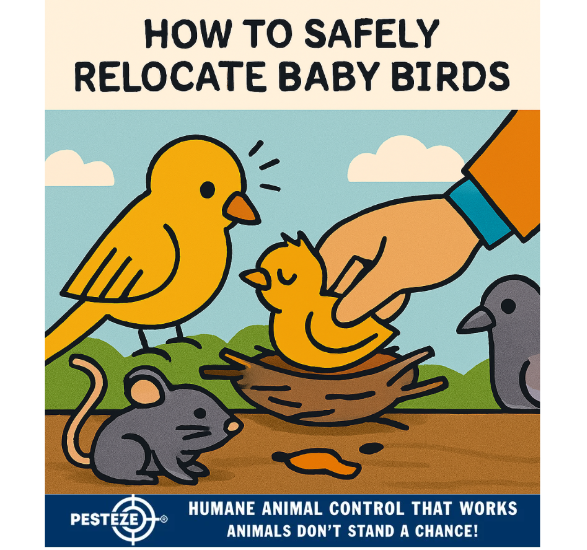HOW TO SAFELY RELOCATE BABY BIRDS

HOW TO SAFELY RELOCATE BABY BIRDS
SUMMARY
Relocating baby birds is a delicate process that requires compassion, caution, and knowledge of wildlife behavior. Whether a nest has been disturbed or a fledgling is found in harm’s way, improper handling can lead to injury or abandonment. This guide outlines safe, humane, and legally sound methods for relocating baby birds. With the right approach, you can protect vulnerable chicks while respecting nature’s balance.
FEATURES
-
Assessing the Situation: Determine if relocation is necessary or if the bird is simply fledging.
-
Identifying the Species: Understand species-specific needs and legal protections.
-
Using Proper Handling Techniques: Learn how to gently and safely move baby birds.
-
Choosing a Safe Relocation Site: Select nearby, sheltered areas that mimic the original habitat.
-
Avoiding Human Scent Transfer: Use gloves or clean hands to prevent parental rejection.
-
Knowing When to Call Experts: Contact wildlife rehabilitators for injured or orphaned birds.
GUIDE DESCRIPTION
Finding a baby bird outside its nest can be alarming, but not every situation calls for intervention. This guide helps you determine when and how to safely relocate baby birds without causing harm or violating wildlife laws.
Start by observing the bird’s behavior. Many fledglings leave the nest intentionally and are still cared for by nearby parents. If the bird is alert, feathered, and hopping, it may not need help. However, if it’s exposed to predators, injured, or in a hazardous location (like a busy sidewalk or driveway), relocation may be necessary.
Identify the species if possible. Some birds, like raptors or songbirds, have specific nesting habits and legal protections under the Migratory Bird Treaty Act. Avoid relocating protected species without professional guidance.
When handling baby birds, use clean gloves or sanitized hands to minimize scent transfer. Gently cup the bird and avoid squeezing or startling it. Never attempt to feed or give water unless instructed by a wildlife expert.
Relocate the bird to a shaded, sheltered spot near the original location—ideally within 10–20 feet. This allows the parents to find and continue caring for it. Avoid placing the bird in direct sunlight or open areas where it’s vulnerable to predators.
If the bird appears injured, orphaned, or is a nestling with no visible nest nearby, contact a licensed wildlife rehabilitator immediately. They have the training and resources to provide proper care.
By following these steps, you’ll ensure the baby bird has the best chance of survival while minimizing human interference. Responsible relocation supports wildlife conservation and fosters respectful coexistence with nature.
- Amy Chang


Comments 0